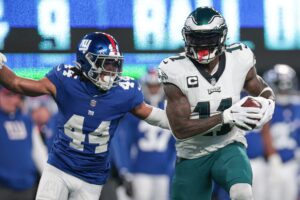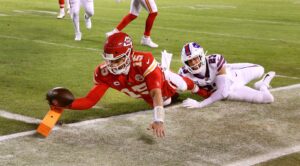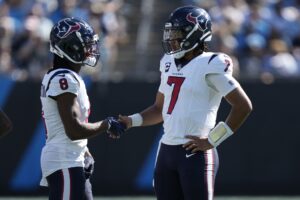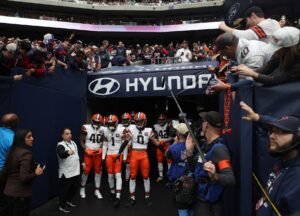If I was given one wish for the 2020 Fantasy Football season, it would be to properly handicap the RB1 opportunity share for every NFL team. That position is the most critical this season, with an overwhelming number of running backs being drafted in the first two rounds. When projecting the opportunity share for the upcoming season, it is important to include several different factors.
Projecting RB1 Opportunity Share For Each NFL Team: AFC East
Most fantasy drafters simply examine the running back opportunity share based on past performance and if a new running back was added to the depth chart. Those factors are not nearly as important as how that running back performed last season in games they were healthy and received the majority of touches. Even if a reduced sample, it provides the best window into the potential opportunity share for the 2020 season.
For each team’s projected starting running back, I listed the opportunity share from the 2019 season in games they started and did not leave due to injury. For players that joined new teams (i.e Todd Gurley in Atlanta), I used the stats from last year’s primary starting running back (i.e. Devonta Freeman). While the skill set may not match perfectly, it gives us a strong projection of usage for 2020.
In this eight-part series, we will examine the projected lead running backs for each NFL division. Let’s examine with the AFC East.
Buffalo Bills
2019 RB: Frank Gore
Games: 12
Rushes: 39.74 percent
Rushing Yards: 47.40 percent
Targets: 10.73 percent
Receptions: 12.55 percent
Receiving Yards: 7.10 percent
Touchdowns: 13.79 percent
2020 RB1: Zack Moss; Devin Singletary
Positive Regression From Frank Gore Purgatory: Buy Zack Moss in Best Ball Drafts https://t.co/gYeRBSrweP pic.twitter.com/aCt6GV24ha
— RotoViz Dynasty (@RotoVizDynasty) June 23, 2020
Outlook: Frank Gore was the lead rusher in Buffalo last season, but Singletary provided enough of a 12-game sample for reasonable analysis. There is upside for the second-year Florida Atlantic product who managed 12.3 PPR fantasy points per game on just 39.74 percent of the Bills rush attempts. Singletary received quality receiving volume with over 10 percent of the team targets and receptions. He saw his weekly snap share rise from Weeks 10-14. However, the impact of third-round rookie Zack Moss is legitimate, with a much more attractive ADP. At 223 pounds with strong receiving skills from Utah, Moss is likely the best all-around running back on the Bills roster. Singletary’s RB29 ADP is decent, but Moss’ RB46 ADP is an absolute steal.
Miami Dolphins
2019 RB: Kenyan Drake
Games: 5
Rushes: 45.56 percent
Rushing Yards: 52.58 percent
Targets: 16.29 percent
Receptions: 19.59 percent
Receiving Yards: 12.43 percent
Touchdowns: 0 percent
2020 RB1: Jordan Howard/Matt Breida
Social distancing.#FlashbackFriday to @MattBreida taking it to the house. pic.twitter.com/wbL2POsWeZ
— San Francisco 49ers (@49ers) March 28, 2020
Outlook: In 2019, quarterback Ryan Fitzpatrick‘s 243 rushing yards were 42 more than any Dolphins running back. I used Kenyan Drake’s five-game sample (before getting traded to Arizona) as the basis. Drake received a strong 16.29 percent of the team’s targets mostly due to a wealth of negative game script. This should be a two-headed backfield attack with Jordan Howard getting the rushing work and Matt Breida the passing volume. With both players holding similar ADPs around RB 40, the play here is to take Breida’s reception volume on what still should be a sub-.500 team.
New England Patriots
2019 RB: Sony Michel
Games: 16
Rushes: 55.26 percent
Rushing Yards: 53.55 percent
Targets: 3.41 percent
Receptions: 3.17 percent
Receiving Yards: 2.26 percent
Touchdowns: 16.67 percent
2020 RB1: Sony Michel?
At a deep position, Patriots running back Damien Harris could break through https://t.co/vx6zNpTXmw
— Boston Globe Sports (@BGlobeSports) June 18, 2020
Outlook: As a result of minimal passing-game usage, Michel’s fantasy impact is tethered to high rushing volume. With 55.26 percent of the Patriots rushing attempts last season, Michel was in the range of Todd Gurley (58.84 percent) and Philip Lindsay (54.77 percent). The obstacles in 2020 include recovering from off-season foot surgery, a drastic quarterback change, and a decrease in positive game script. If New England is trailing, fellow running backs James White and Rex Burkhead are better fantasy options. There are also rumors of last year’s third-round pick Damien Harris getting an opportunity in the preseason. While Michel’s RB37 ADP is still low, his lack of passing game involvement makes him a risky investment even in standard fantasy formats
New York Jets
2019 RB: Le’Veon Bell
Games: 15
Rushes: 69.8 percent
Rushing Yards: 68.91 percent
Targets: 17.07 percent
Receptions: 21.78 percent
Receiving Yards: 14.57 percent
Touchdowns: 9.76 percent
2020 RB1: Le’Veon Bell
List of 2019 RBs that accounted for over 60% of team rushing attempts & over 20% of team receptions in full games played:
-C. McCaffrey (74.4%, 30.4%)
-L. Fournette (72.6%, 22.6%)
-L. Bell (69.8%, 21.8%) 👀
-J. Conner (60.6%, 20.2%) 👀— Mike Randle (@RandleRant) June 15, 2020
Outlook: Even as the rift between head coach Adam Gase and his lead running back continues to grow, the opportunity share for Le’Veon Bell remains among the highest in the league. Bell ranked eighth in total team carries and fifth in running back target share. Even in a season in which he finished as only the PPR RB18, he still demanded a usage that rivals any NFL running back. There are very few players in fantasy football being drafted outside the Top 20 at their position that can make a legitimate argument for finishing at their positional Top 5. With just some positive touchdown regression, Bell possesses that result in his range of outcomes with respect to RB1 opportunity share.






